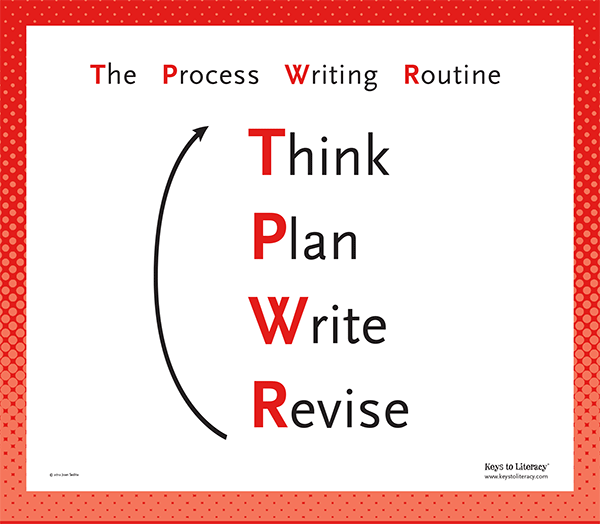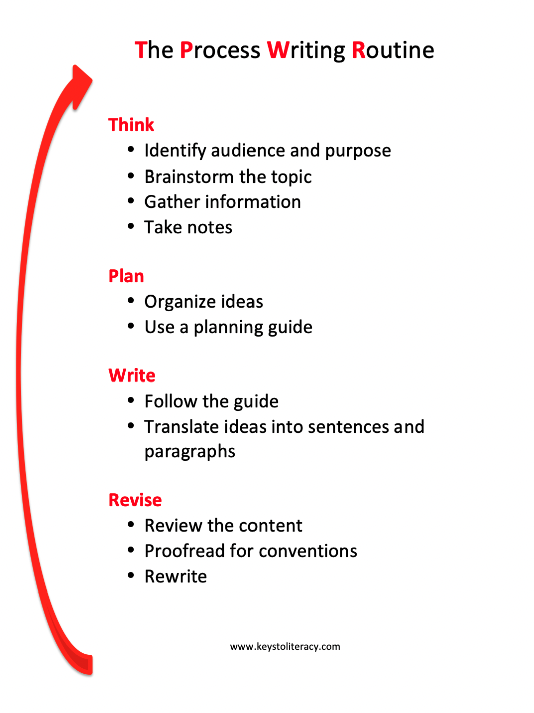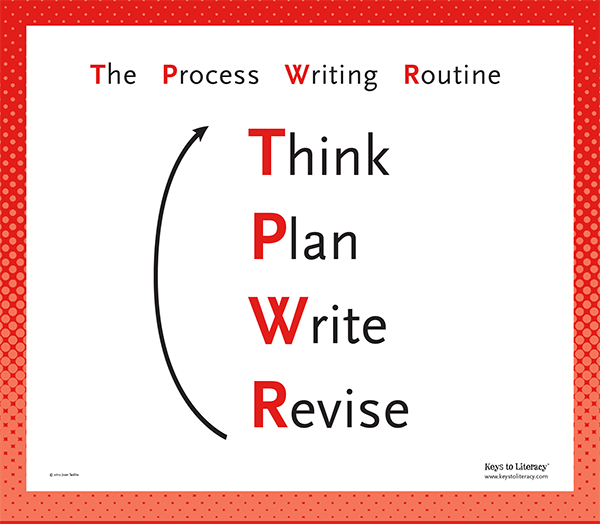Stages of the Writing Process

Beginning in the 1960’s, Hayes and Flower (1980) researched the steps that proficient writers take in order to better understand how to teach writing. They initially developed a model of the writing process with three stages: planning, translating, and reviewing. Over the years, the model was informed by new research and modified to include four stages (Hayes, 1996, 2004): Pre-Writing, Text Production, Revising, Editing. Today, it is accepted practice that students be taught to follow the stages of the writing process when they write.
One of the Common Core anchor writing standards focuses on the writing process: Develop and strengthen writing as needed by planning, revising, editing, rewriting, or trying a new approach. The Institute of Education Sciences research guide Teaching Elementary School Students to Be Effective Writers (Graham et al., 2012) recommends teaching students to use the writing process for a variety of purposes, noting, “It is a process that requires that the writer think carefully about the purpose for writing, plan what to say, plan how to say it, and understand what the reader needs to know.” The report goes on to explain, “Writing is not a linear process, like following a recipe to bake a cake. It is flexible; writers should learn to move easily back and forth between components of the writing process, often altering their plans and revising their text along the way. Components of the writing process include planning, drafting, sharing, evaluating, revising, and editing.” (pp 12, 14)
Teaching the Stages of the Writing Process
Ten years ago I proposed a model for teaching the writing process that includes four stages: THINK, PLAN, WRITE, REVISE. The title of this model, The Process Writing Routine, is designed to help students recall the stages of the writing process by linking the four stages to the first letters of the words in the title. The graphic below shows the four stages with details about the tasks associated with each stage. One of the modules in the Keys to Content Writing professional development course is focused on the stages of the writing process Click here to access a copy of this handout from the free resources section of the Keys to Literacy website.

As the IES guide notes, writers repeat and revisit the stages several times as they develop a piece of writing. For example, students may realize while they are writing a first draft of an informational piece that they need to go back to the THINK stage to gather more information about the topic. While revising the draft, they may determine that they need to go back to the PLAN stage to reorganize the content. The arrow serves as a reminder that writing stages are overlapping parts of a process that may be repeated multiple times as writing unfolds.
It is helpful to provide a visual reminder of the writing process to students such as displaying The Process Writing Routine in a classroom anchor chart, as a handout for students to keep in their notebooks, or as a digital resource file. The poster shown below is available from Keys to Literacy.

Too often, students assume the focus of their attention should be on writing. They do not spend sufficient time at the THINK and PLAN stages, or they skip them altogether. The amount of time spent on each stage will vary depending on the writing task, but a common recommendation is to spend 40% of the time reading, gathering ideas and information, and taking notes (THINK and PLAN); 20% of the time draft writing (WRITE); and 40% of the time rewriting and revising, including editing for conventions (REVISE). Students need to learn that in most cases, spending more time at the THINK and PLAN stages will produce a better writing draft and save time at the REVISE stage.
Introducing the Stages to Young Students
I have simplified the stages for young students in the primary grades, as shown below and addressed in one of the modules in the Keys to Early Writing professional development course. The more basic model combines the first two stages and includes visual cues. A copy of this graphic is available at the free resources section of the Keys to Literacy website.

Students in kindergarten and grade 1 may not be developmentally ready to formally revise their work and instead may focus their editing on adding more to their drawings, labels, phrases, or sentences. View the suggestions below for introducing young students to the stages of the writing process.
- THINK & PLAN:
- Generating Ideas and Organizing: What do I want to say? How will I present what I want to say?
- WRITE
- Using Drawing and Words: How can I use drawings, words, and sentences to communicate what I want to say?
- REVISE
- Improving: Can I add more detail to my drawing or words?
Teaching Students Strategies for Each Stage of the Writing Process
Research consistently confirms that teaching strategies to students for planning, revising, and editing their writing pieces can have a dramatic effect on the quality of their writing (Graham & Perin, 2007; Graham et al., 2012; Graham et al., 2017). Strategy instruction involves explicitly teaching generic processes such as peer collaboration or note taking, or strategies for accomplishing specific types of writing tasks such as writing a summary or a story. Some strategies incorporate a scaffold such as a graphic organizer or a writing template. The following earlier blog posts provide instructional suggestions for writing strategies:
- Teaching Text Structure to Support Writing and Comprehension
- The Might Paragraph
- Teaching Handwriting
- The Power of Transition Words
- Syntactic Awareness: Teaching Sentence Structure Part 1
- Syntactic Awareness: Teaching Sentence Structure Part 2
- Explicit Instruction of Note Taking Skills
- Patterns of Organization
RELATED RESOURCES
- Video: Teach Students to Use the Writing Process for a Variety of Purposes (Institute of Education Sciences)
- The Writing Process (University of Kansas Writing Center)
- Stages of the Writing Process (Purdue Online Writing Lab)
REFERENCES
- Graham, S., Bollinger, A., Booth Olson, C., D’Aoust, C., MacArthur, C., McCutchen, D., & Olinghouse, N. (2012). Teaching elementary school students to be effective writers: A practice guide (NCEE 2012- 4058). Washington, DC: National Center for Education Evaluation and Regional Assistance, Institute of Education Sciences, U.S. Department of Education.
- Graham, S., Bruch, J., Fitzgerald, J., Friedrich, L., Furgeson, J., Greene, K., Kim, J., Lyskawa, J., Olson, C.B., & Smither Wulsin, C. (2016). Teaching secondary students to write effectively (NCEE 2017-4002). Washington, DC: National Center for Education Evaluation and Regional Assistance (NCEE), Institute of Education Sciences, U.S. Department of Education.
- Graham, S., & Perin, D. (2007). Writing next: Effective strategies to improve the writing of adolescents in middle and high schools – A report to Carnegie Corporation of New York. Washington, DC: Alliance for Excellent Education.
- Sedita, J. (2020). Keys to Early Writing. Rowley, MA: Keys to Literacy.
- Sedita, J. (2020). Keys to Content Writing. Rowley, MA: Keys to Literacy.

 Joan Sedita is the founder of Keys to Literacy and author of the Keys to Literacy professional development programs. She is an experienced educator, nationally recognized speaker and teacher trainer. She has worked for over 35 years in the literacy education field and has presented to thousands of teachers and related professionals at schools, colleges, clinics, and professional conferences.
Joan Sedita is the founder of Keys to Literacy and author of the Keys to Literacy professional development programs. She is an experienced educator, nationally recognized speaker and teacher trainer. She has worked for over 35 years in the literacy education field and has presented to thousands of teachers and related professionals at schools, colleges, clinics, and professional conferences.
Leave a Reply